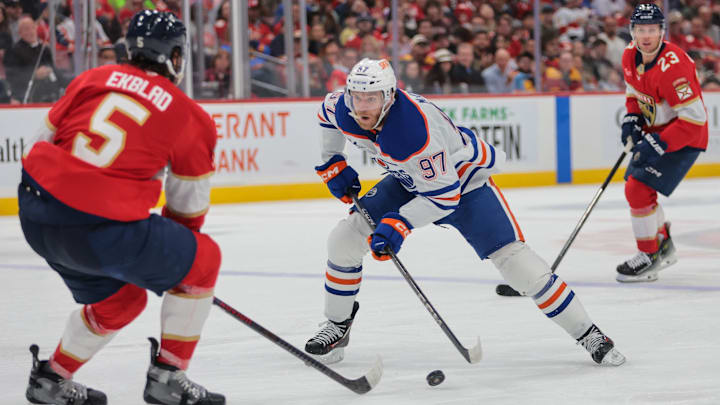The 2025 Stanley Cup Final between the Edmonton Oilers and Florida Panthers is loaded with elite offensive talent, but it may ultimately come down to which defensive corps can better handle the pressure and suppress the opposition’s firepower. Here's a head-to-head look at how the two blue lines stack up, and who might have the edge when the puck drops.
Florida Panthers Defensive Group
Top Pair: Gustav Forsling – Aaron Ekblad
Gustav Forsling continues to be one of the league’s most underrated shutdown defenders. His elite skating and gap control allow him to neutralize top lines, and he’s been logging major minutes this postseason. Aaron Ekblad, though not as flashy as in years past, provides experience, physicality, and a booming shot. Together, they form a balanced duo capable of playing 25+ minutes per night and matching up against anyone.
Middle Pair: Dmitry Kulikov – Seth Jones
Jones was a late-season acquisition who’s brought size, puck-moving ability, and playoff composure to Florida’s second pair. Kulikov is a steady, physical presence who complements Jones well, letting the latter jump into the play when needed. While this pair can be hemmed in at times, they’ve held up well in the playoffs and have mostly avoided costly mistakes.
Bottom Pair: Nate Schmidt – Niko Mikkola
This third pairing plays limited minutes, but they’ve been effective. Mikkola uses his long reach and size to break up plays, while Schmidt brings veteran savvy and mobility. They’ve avoided becoming liabilities, exactly what you want from a bottom unit in the playoffs.
Overall Strengths: Structure, discipline, experience, physicality.
Weaknesses: Limited offensive production beyond Ekblad and Jones.
Edmonton Oilers Defensive Group
Top Pair: Mattias Ekholm – Evan Bouchard
This is the Oilers’ engine from the back end. Bouchard is producing at an elite level this postseason and is a power-play quarterback and breakout machine. Ekholm, who has just been inserted into the lineup after a long injury, is calm, positionally sound, and a leader on and off the ice. This pairing drives possession and can dominate stretches of play.
Middle Pair: Darnell Nurse – Brett Kulak
Nurse’s physical tools are undeniable, but inconsistency continues to plague him. When he’s on, he’s a force, when he’s not, turnovers and bad penalties creep in. Kulak remains one of Edmonton’s most dependable defenders and often covers for Nurse’s aggressiveness.
Bottom Pair: Jake Walman – John Klingberg
Walman, acquired at the deadline, brings puck-moving ability and decent mobility. Klingberg is the wild card. While he can still flash offensive upside, defensive struggles and injuries have limited his impact. This duo may be sheltered, but they’ll be tested by Florida’s deep forward group.
Overall Strengths: Offensive creation, breakout ability, top pair dominance.
Weaknesses: Depth consistency, turnover risk, defensive-zone coverage.
Who Has the Edge?
Edge: Slightly Edmonton Oilers
While Florida’s group is steady and reliable, the Oilers' defense has been better at locking games down when it matters most, especially over the last two rounds. Edmonton has limited high-danger chances, closed out tight third periods, and supported elite goaltending play with improved defensive structure. Their top four is thriving, and even their depth has stabilized.
Florida is still formidable, but if this series becomes a battle of bluelines, Edmonton’s top-end talent and ability to elevate in big moments gives them the edge.
